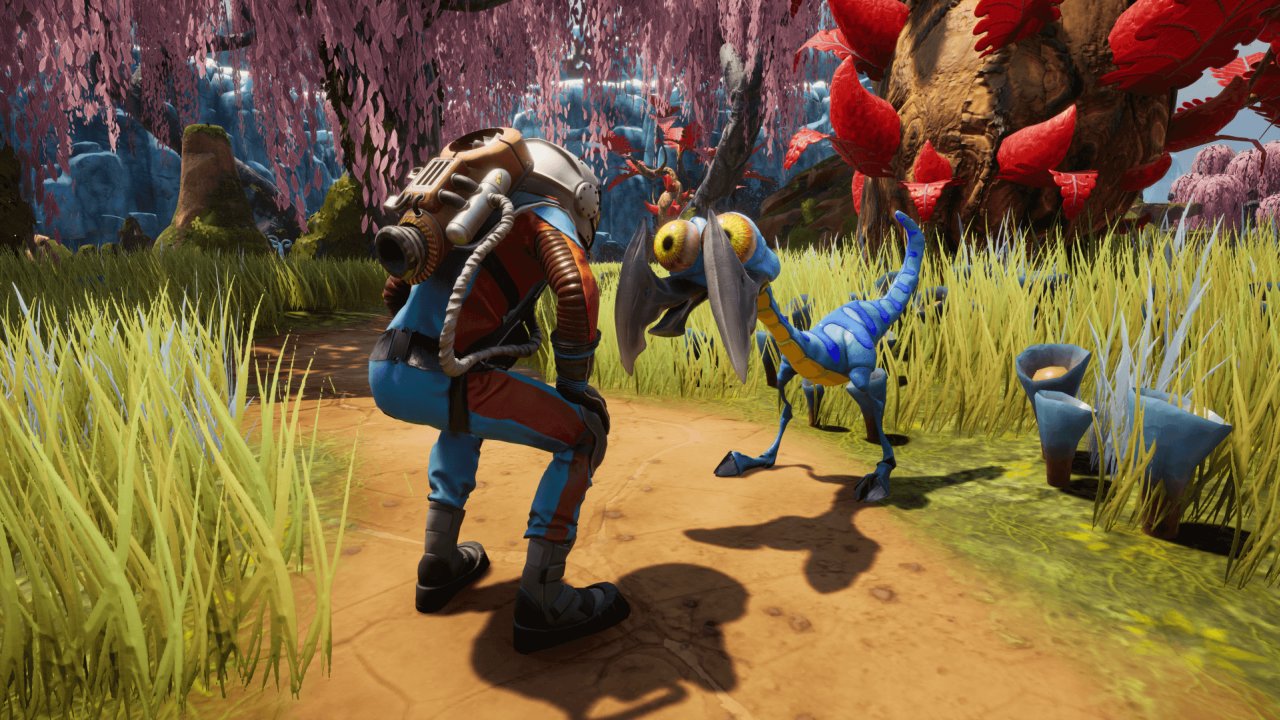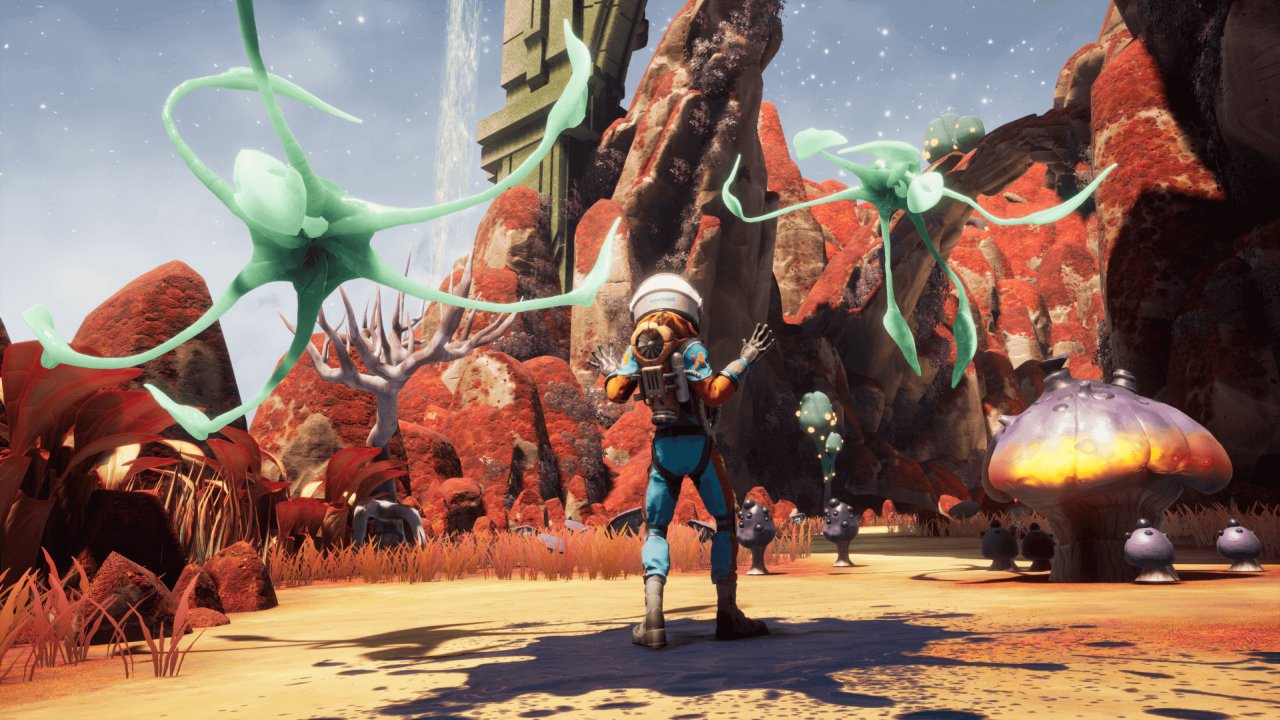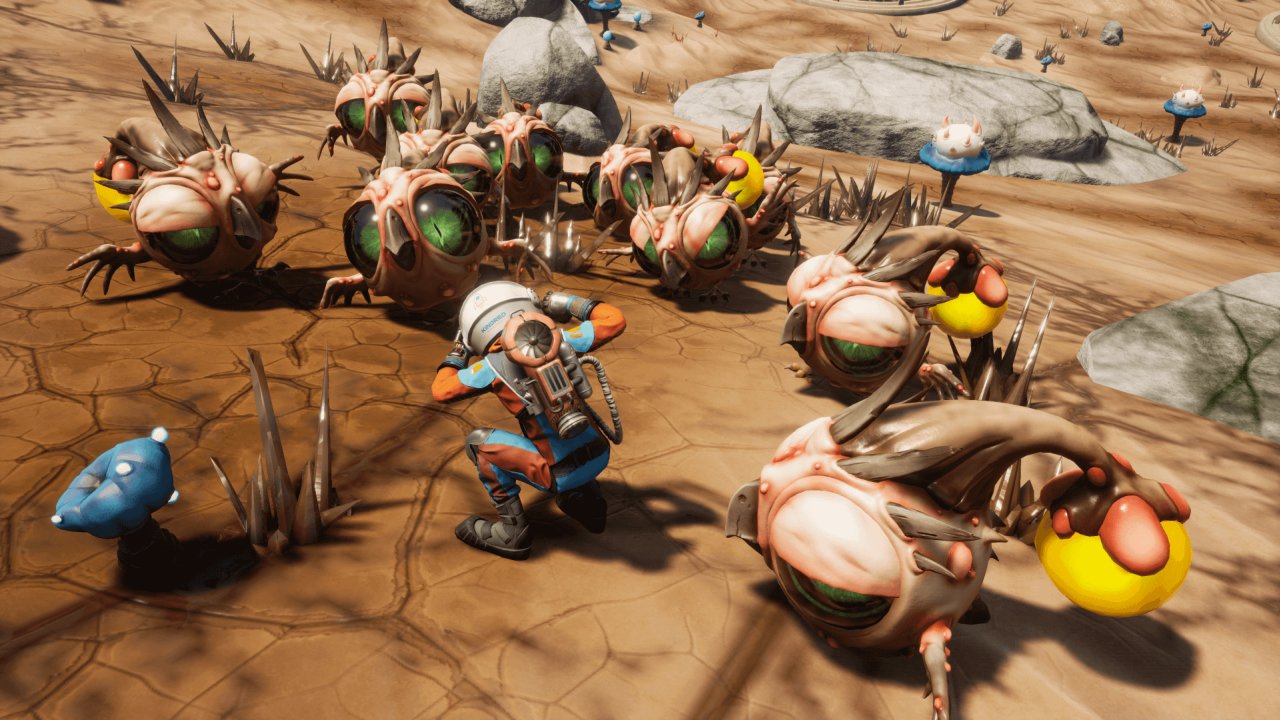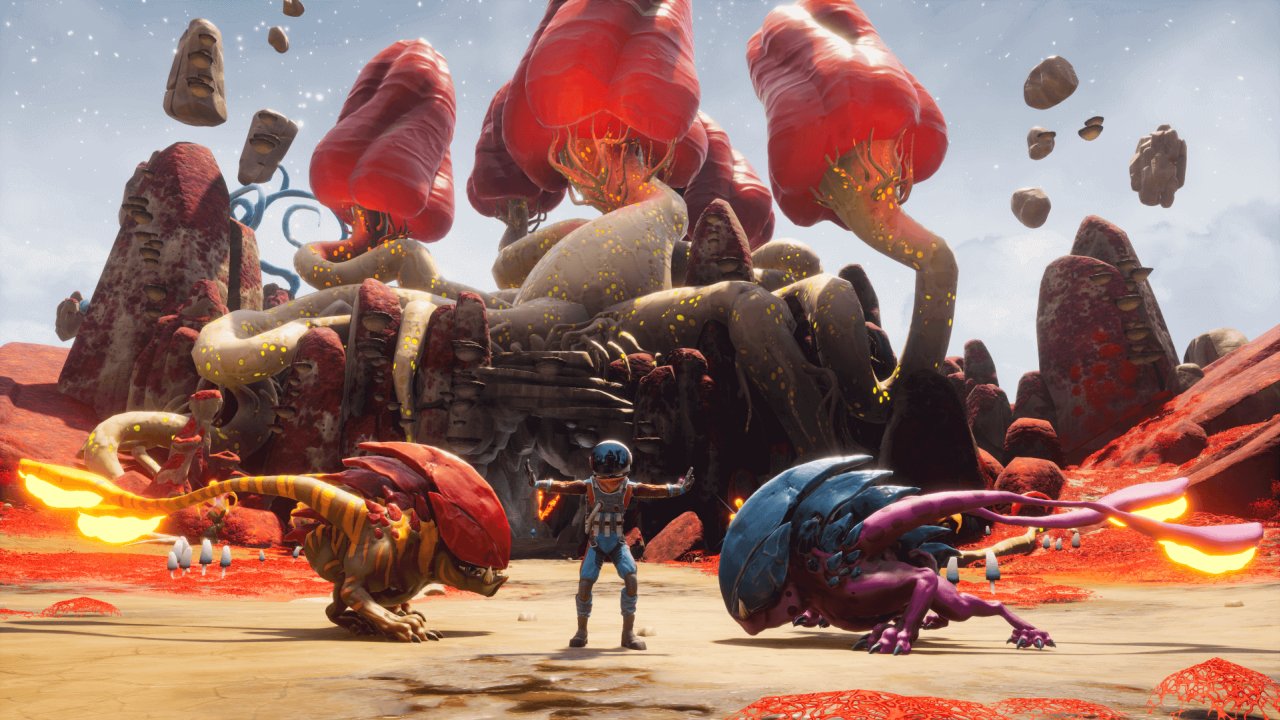Journey to the Savage Planet Review
A short space odyssey through weird and mysterious lands
Much like the planet you are sent to explore in Journey to the Salvage Planet (JSP), this kind of game was uncharted territory for me. I cannot think of any game I played recently that is truly comparable to it (but that perhaps is my fault). JSP, developed by Typhoon Studios, is fundamentally a light-hearted adventure game which integrates bits and pieces of other genres. It has platformer elements, it offers FPS combat sequences and presents the players with the occasional 'puzzle' (though this last description must be taken with a huge heap of salt). Despite all of these very different souls within it (some more developed than others), JSP ultimately manages to integrate them in a harmonic way. None really detract from game's main direction: an adventure to unlock the mystery behind the planet you are sent to survey. What did however hinder my experience was the game's length and ease. JSP is extremely permissive and can be finished in less than 10 hours.

The main story premise centers around the anomaly that manifests in your mission. That is, you (the unnamed protagonist) are sent to the apparently uninhabited planet AR-Y 26 to chart its suitability for human colonization. However you soon realize (from the massive tower that stands above in the air from where you landed) that you have been preceded by other intelligent life forms. You are ordered by your eccentric boss - CEO of Kindred Aerospace Martin Tweed - to investigate.
With this task in mind you are sent on your own personal little odyssey, full of detours and hostile encounters, before you meet the conditions necessary to get into your intended destination. I found the narrative framing of the game very appealing in itself. Space and odysseys just go well together. And the alien world you are presented with is filled with interesting landscapes, creatures and vegetation design styles (they felt a bit like Jumanji on acid, an appealingly 'pulpish' characterization of outer space). What however I did find a bit disengaging narrative-wise was how the story constantly progresses by deus-ex-machinas. The game presents you with a mystery, yet many details are seemingly conveyed by messages from your CEO or your AI companion EKO without you actually having to investigate. Similarly, the second you meet an obstacle, EKO will reveal to you immediately the location of the upgrade shrine needed to overcome it. Again, the solution is handed to you (as well as undermining the whole “exploration and adventure” aspect of the game).
An important aspect to JSP's narrative is its humorous overtones. From Tweed's video messages and EKO's constant commentary, to the spam email and TV ads played while in the hub area, the game is laden with comedy. Yet not all landed that well with me. I was very indifferent to all of Tweed's bits, his eccentricities not being enough to elicit a laugh. Meanwhile, the ads and spam you can listen/read while in the hub area get old quickly. Although discussing very topical matters, many follow the same scheme. Sometimes, they take a hot issue and then proceed to depict a future in which the problem has reached grotesque heights (the comedy being in the magnitude that the problem has achieved). Others instead simply depend upon presenting extremely absurd goods and services. Though both schemes are funny the first couple of times, they get repetitive.
EKO, whose voice accompanies you throughout your adventure, instead manages quite well to keep the game lighthearted. Reminiscent of GLaDOS from Portal, the AI's general disregard for the protagonist's life and its minimizing of the player's dire situation do bring comic relief to the game. As well there were many smaller elements, connected to gameplay, that garnered laughs (or rather smiles) from me. For example, I found humorous the fact that Kindred essentially strands you on the planet - giving you only the fuel for the way there - and making the fuel to get home one of the in-game collectibles. Or that to takedown a creature like the 'Sproutlook', a hostile plant with a giant eye, it requires a melee attack which involves an animation in which you poke it in its massive eye. It is things like these that create a very enjoyable mood in the game.

Gameplay wise, JSP's core experience can be compared to those point-and-click adventures of old. You have a very linear progression in which you'll be presented with sudden insurmountable obstacles. You'll then be redirected by EKO to another area which has the necessary upgrade for you to surpass the impasse. To unlock it you'll be required to overcome some sort of challenge (generally a platforming or combat one). After that you'll have to gather resources necessary to craft it (this is relatively easy and non-grindy) and a conveniently placed teleporter will take you back to the hub where you can produce it. You then backtrack to the obstacle, overcome it and move on to the next area. This is the main way by which your adventure on the savage planet progresses. Although formulaic, the differences in level design and challenges thrown at you do manage to keep the game fresh.
There is another, secondary, pillar to the “adventure” component of the game: collectible hunting. This will encourage you to explore the entirety of the map for each of the four biomes/stages. Collectibles can be split in three categories: those which enhance the narrative (alien videos and logs from a previous explorer), those needed to trigger the game's endings (ship fuel) and those that improve your stats or allow you to craft upgrades (edible goo and alien alloys). To gather these you'll have to look between the many nooks and crannies of a level. Sometimes gathering these collectibles will require you to unlock one of the main storyline upgrades from later on in the game (meaning that you can only access the collectible later on in the campaign). Other times however it is all a matter of diligent searching. All of the alien alloys instead require you to complete a challenge. Like the story upgrades, these might involve a combat or platforming sequence or even a trivial puzzle. Although collectible hunting is generally very tedious and full of backtracking (which interrupts the flow of the game), the developers give a massive hand to players by giving them upgrades to their scanner which reveals all collectibles in a large area. Despite removing a good chunk of the challenge behind this activity, this is something which I personally condone given its tediousness.
The combat portion of the game centres on you fending off the hostile fauna of the savage planet with your trusty laser pistol. As you progress, you'll be able to unlock up to 14 upgrades for it. Most tend to focus on upgrading the stats of the gun. However, you'll also be able to unlock three special attacks (i.e. a ricochet shot which explodes on the last shot) which require a Gears of War-like reload minigame to activate them. The game also has a number of throwables (which generally take the form of harvested plant organism from the planet) of which four can be used to influence combat.
Excluding some early enemies, most fights are technically meant to carry out in a loosely darksolesque manner (especially boss fights). You are supposed to use your 'jetpack dodge' to weave around the enemy attack until they are exhausted or they expose their weak-spots for attack. However I found that many of the bosses are immobile, their attacks are too slow/telegraphed and their weak spots are targettable from the outset. This made for very relaxed fights, with little active engagement on my behalf (I was rarely on the edge of my seat). Meanwhile for the more mobile enemies, which require you to dodge their attacks to actually expose their weak points, these could be easily overcome by using the plentiful 'binding bile' throwable. This will essentially root the enemy to the ground for many seconds, exposing them for easy killing. Occasionally enemies will have an extra layer of armour that makes them invulnerable. But this is easily overcome by using a specific throwable with a large area of effect, therefore adding just a tedious step to combat (one that requires little skill). This said, the sounds and visual effects in combat are very commendable, and pack a punch. The explosions, the revving of your gun when charging a special attack, or the smoke clouds left by jetpack dodging are all things that do give a very rewarding appearance to combat.

Halfway through the second level, you'll reach a point where your platforming will feel so rewardingly fluid. By then you'll have unlocked the double (maybe even triple) jump, the boosted jump, and the capacity to grapple and grind on certain plants. These abilities, and the capacity to chain them, all make traversing a level truly an enjoyable and cinematic experience. What I find disappointing is that there are some situations in which platforming requires very little player input. Excluding some segments which involve more conventional freeform platforming, there are several moments in which your movement feels locked on rails. For example, when taking a grapple flower or grapple rail, the game automatically guides you to where it wants you to go. It will then put you in a situation where you have to generally press a single button, maybe two, before you reach your destination. These portions, though resulting in very cool-looking sequences, make for unengaging gameplay.
Calling 'puzzles' some of the challenges the game presents would be a massive overstatement. There are two fundamental kinds of these which have to be resolved in order to access certain collectibles. Some involve very simple pattern recognitions and/or use of very intuitive game mechanics (available from the start of the game). For example opening up a 'meat vortex' placed high on a rock, requires the very obvious use of the 'bait' and 'gelatinous blob' throwables. Others instead involve finding either three glyphs or pustules which need to be scanned or destroyed in order to open a chest. These are all in the immediate vicinity of the container. Finding them is a very un-challenging task. Honestly the most difficult aspect to these 'puzzles' is how to get to the specific nook or cranny which contains them.
As alluded to previously, one the most evident weaknesses of the game is its excessive ease. The game is too forgiving on the player. Consider again the combat sequences. Already the different enemies thrown at you by the game aren't very challenging. Rarely have they ever come close to deplete my health. Despite this, the developers fill each area which such a number of health packs (which take the form of plants which can be harvested every 2 minutes or so) to the point that it becomes more of a challenge to find ways to die during these battles. Platforming as well has many 'get out of jail free cards'. About to fall from a devastating height? Just press space and jetpack jump before landing. Precipitated into a pit of acid or lava? You don't die instantly; rather your life bar starts being drained at a set pace. Fall from a platform into the void? You are brought back at the very ledge you jumped from at the cost of 2.5 health bars. A number of these issues are the product of your character's unreasonable health pool. As you start harvesting the edible goo collectible, your health and stamina start increasing. Although these upgrades are eventually capped, your health scales at such a point where most damage sources become negligible. And this produces very counterintuitive situations. For example, you can easily run through a lava pit to fetch a collectible, avoiding all platforms meant to be taken, and still have about 2/3rd of your life bar. Tweaking these values, I believe, would result into much more rewarding gameplay.
There is also something to be said about the length of the game. I am by no means a talented player nor am I speedrunner capable of dissecting gameplay and spotting exploits. Yet, at 9 hours, I managed to finish all missions with a 91% completion rate. This was achieved with me going considerably out of my way to pick-up many, but not all, collectibles (and the necessary five fuel units to play the end credit scene). At 11 hours and 57 minutes, I fetched all remaining collectibles for a 98.3 completion rate (missing only 15 survey entries out of 190 for the game's codex). I think it then reasonable to say that the game, as it stands now, offers a somewhat limited amount of content to players.

One thing I think remains worthy of praise is the fact that the game can be played in two player co-op. Although this does not alter significantly the experience (like Portal 2 which adds a whole new co-op campaign, different from the single player), multiplayer functionality is a plus. And, unlike some more recent games, there is no 'tethering' mechanic to JSP's co-op. Player two is not forced to stick close to the host, meaning that both players can split up and explore the opposite ends of a stage's map. There are however certain aspects to JSP's multiplayer which can be made out to be considerable flaws. Firstly, having two players in a session makes the game even easier. Other than making combat trivial, with two players being able to output much more damage and have double the amount of throwables available, collectible hunting also loses even more of its challenge. Since only one player has to pick the collectible up for both to get the credit, players can split up and scour the map with ruthless efficiency. Secondly, all progress made in co-op goes towards the host's save file. If player two wants to then continue playing in singleplayer, and has played only in co-op up to now, he'll have to start the game anew. If say your co-op host is never online, this limitation can prove to be a considerable frustration.
Despite some of its more apparent flaws, I did find Journey to the Savage Planet to be quite relaxing. Not once during the whole review process have I hesitated to boot it up to play it some more. Despite not being very challenging, this fundamentally 'casual' experience has many virtues to its name. It can be fully enjoyed in two player coop. Its light-hearted tone, the intriguing mystery presented to the player and the unique looking/sounding ecology of AR-Y 26 make for very interesting world-building. The core gameplay, though requiring no particular skill, is scenic and still gives you a sense of accomplishment (although perhaps it might be a bit unwarranted).
 Comments
Comments


















